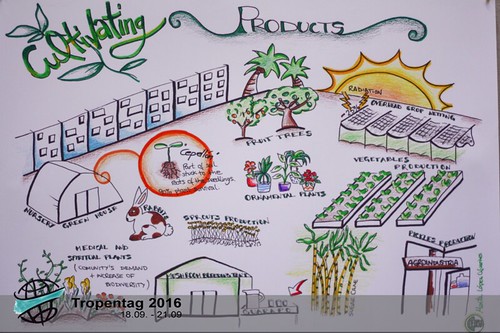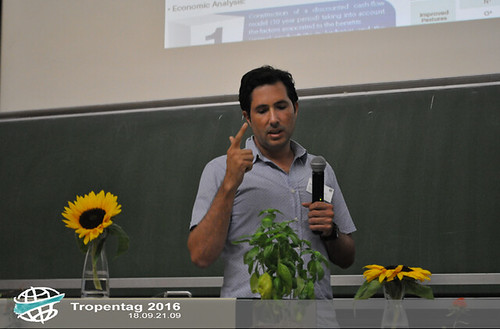Poster sessions 2016
Bringing communities together for sustainable and fair use of forestry resources in Chobe, Botswana
Wed, 09/21/2016 - 16:12 — Kootlole
Toxins in Tropical Food Production
Wed, 09/21/2016 - 16:04 — BackhausDo you know what rice consumption in Nigeria and milk consumption in Kenya have in common? It’s something that both livestock and crop farmers, especially in developing countries, have to deal with: the risk of exposure to mycotoxins in food. One could hear about this topic today, last day of Tropentag 2016, in the fourth oral presentation about food security and nutrition, as well as yesterday in the third poster session about mobile dryland pastoralism. I had the chance to hear both Olusegun O. Atanda’s and Caroline Makau’s research results about such an issue on food safety, which is considered as a specific problem of tropical regions. Exposure to mycotoxins, in fact, should be as low as possible since these are genotoxic and carcinogenic.
In Kenya, aflatoxins (a type of mycotoxin produced by Aspergillus, a species of fungus) pose a safety risk in cow milk. Research revealed that this resulted from poor feed storage and on field infestation during plant growth, which then contaminated animal feeds and finally ended up in the milk. Caroline Makau stated that especially rotten maize cobs used as ingredients in on-farm formulated feeds caused this problem, and that contamination was especially high in peri-urban farms.
Olusegun Atanda’s study is mainly a call for doing more large-scale research and for stressing the need to continually monitor mycotoxin levels in rice. As it seems, this subject is worth being followed in the future.
Today's highlights from maize fertilisers and standard management of monocultures
Tue, 09/20/2016 - 15:37 — BackhausIf yesterday was the day for BIOCHAR, today’s topic of the sessions about soil fertility and nutrient management was MAIZE. From strategies to outbalance nutrient insufficiencies for maize production in Kenya, to fertiliser optimisation under weed competition and the economic analysis of maize production, many aspects have been covered.
Jacobo Arango and Stefan Burkart presented their researches about Brachiaria Humidicola.
Godfrey Nambafu summed up his results about the strategies adopted by African indigenous plants to cope with phosphorus deficient soils.
Personally, I really enjoyed Patrick van Damme’s research results about Sesbania Rostrata, which used to grow on abandoned rice fields and can be cropped and then plowed into the soil in alternation with rice thanks to its beneficial effect through nitrogen fixation.
Later on, I went to the first oral presentation about the same subject and attended Enos Onyuka talking about the organic carbon input into the soil by plant residues of African indigenous plants. He also stressed the potential for increasing the organic carbon availability in AIV by the use of appropriate harvesting techniques.
Urban agriculture for more resilience in food security
Tue, 09/20/2016 - 15:09 — BergerDo you know the image of Fidel Castro "smoking" a carrot with the caption „organic by default“? This is pretty much the case of Cuban urban farming practices. When the Soviet block collapsed, farmers were forced to turn to sustainable practices due to a lack of external energy-intensive inputs. At the same time, cities had a need for locally produced food. Today, the city of Havana produces 80 percent of its fruit and vegetable demand within the town borders!
The following picture shows a project by Marta Lopéz Cifuentes, student at BOKU, which is displayed in the registration area.

Today, several events at the Tropentag covered the topic of urban agriculture as a means of enhancing food security (and maybe food sovereignty, too). Cuba is a showcase of urban agriculture, since it has relied on it for several decades already. The government has supported urban agriculture in order to become more independent from imports while farmers appreciated their independence from the state. Surprisingly, despite these two contradictory objectives, policies helped urban producers get access to land, markets and extension services, as the research of Friedrich Leitgeb showed.
Challenges to mobile dryland pastoralists
Tue, 09/20/2016 - 14:27 — BackhausIs it the timing? Am I just choosing the unpopular topics? Is the air-conditioning too cold? I think it is. Or is it common that the audiences at poster sessions are usually rather scarce? In occasion of the poster session about Mobile Dryland Pastoralism (2.2, Tuesday 20th, 9:45 am), I found it especially regrettable that not many people attended. So, I decided to highlight some of my favourite topics of today’s poster session 2.2.
Jenny Bischofberger, for example, presented an interesting poster about the integration of stakeholder's knowledge in land-use management in Namibia, based on interviews analyzing their perception about what is most important to save from degradation in the savannah.
I also appreciated Cornelia Heine’s presentation based on a survey about enabling environment and policies related to pastoralism in 26 countries in Asia, Africa, and Latin America, analyzing pastoralist’s livelihoods.
Learning Crop Production Systems from Around the World
Tue, 09/20/2016 - 14:26 — FadliMany different cropping systems practices have been presented at today's Poster Session, and they come from all around the world. Directly from the University of Basel, for example, Schütz Lukas talked about the application of microbial inoculants as a promising science for sustainable agriculture. She found biofertiliser's use to be a viable technology to be applied in tropical and subtropical soil.

The benefits of bee-pollination on cash crop in Burkina Faso, then, was presented by Katharina Stein, from the University of Wuerzburg in Germany. “So far - she said - there is no report on contribution of bee pollination for crop yield of these crops in Burkina Faso”. In fact, her research shows well how bee-pollination can increase cotton fiber weight by 62% and can just triple the weight of sesame seeds. These numbers are a scientific proof that gratis pollination service by bees can be beneficial for small farmers and stakeholders. Too obvious to remind that natural savannah habitat in Burkina Faso would better be conserved?
Tuesday's Rice Session
Tue, 09/20/2016 - 11:49 — ElsbyTuesday morning’s poster sessions included informative presentations on one of the world’s most important crops: rice! As a Canadian, I know very little about rice, so I was either the worst person for this reporting job, or the best (as I had a lot to learn!).
A few common presentation themes included nutrient management, tillage practices, and water conservation. Most of the research projects took place in African and Asian countries, but Colombia also made an appearance. It seemed it could be agreed upon that there is a need for innovative water management strategies, cover cropping systems, and an increase in knowledge of nutrient cycling.
Nitrogen topics were recurring throughout the session, including a particularly interesting presentation that informed the audience of the horizontal movement of nitrogen in valley growing regions. It was said that as the year’s first spring rains land on the soil, microorganisms are essentially “woken up”, and an unused surge in microbial activity and thus nutrient availability occurs. With no crop planted in the field during this time, many nutrients are lost in the spring rains and runoff. Cover crops could help to mitigate this effect.
Organic markets and certification – Participatory systems but not too much romance please
Tue, 09/20/2016 - 11:23 — LangTalking about the very interesting poster presentations, Tuesday's morning session started with a much striking symposium about the future of the organic market. The content of each presentation can be found online, that is why, here, I rather want to focus on the side questions and discussions that arose during the session.
The first critical point at issue coming up was about the length of a stay for conducting a scientific study and, especially, for developing statements. The chair of the session, Prof. Christian Vogl (BOKU University), recommended that sometimes it is better to formulate hypotheses or research questions instead of concrete statements and conclusions, especially when scientists are conducting a short-term project. In fact, within a few weeks, it does not seem very realistic to get an in-depth insight of any subject.
After the first two presentations, the topics shifted towards organic markets and cooperations. Pauline Deltour presented a study from Florianópolis, SC Brasil: “Short Supply Chains of Organic Food: Socioeconomic Emancipation of Family Farmers?”, showing that agricultural fairs (i.e. weekly farmer markets) present the most emancipatory (concerning high reciprocity and autonomy) potential to farmers, but, nevertheless, they are still too small. That is why the organic farmers in the region also need shops for selling their products in order to guarantee a permanency of income.





